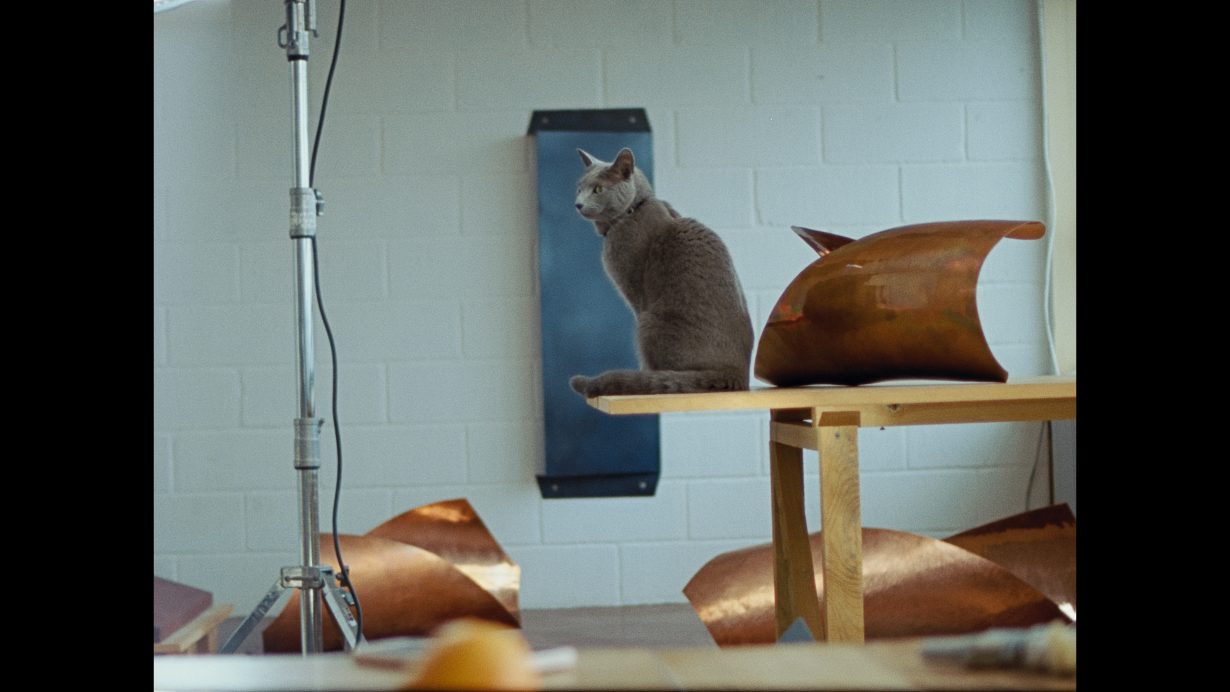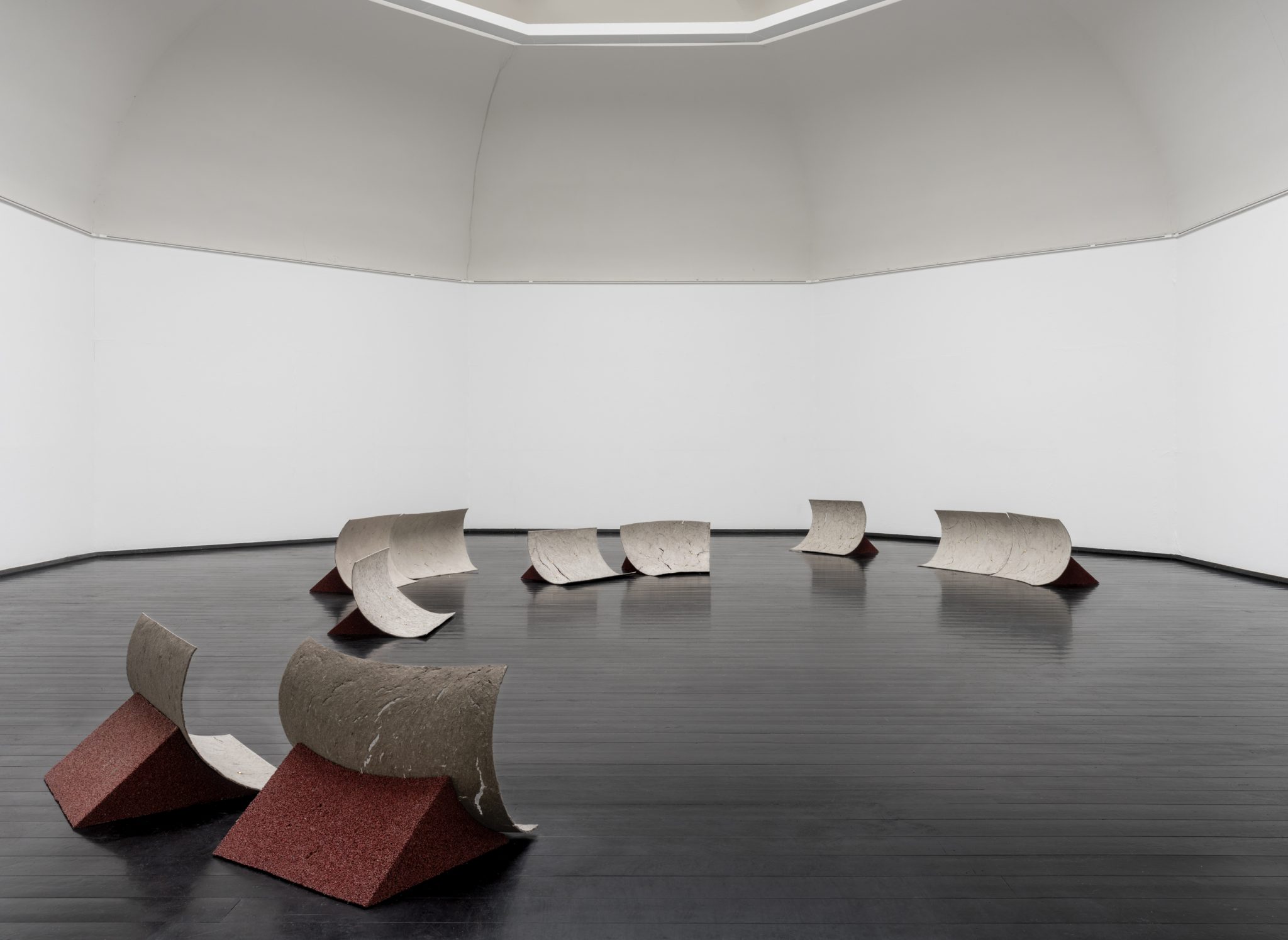O Rose at Den Frie, Copenhagen explores how fleetingly small moments resonate through our lives
In the basement gallery of Den Frie, British-Palestinian filmmaker/painter Rosalind Nashashibi’s 66-minute stream-of-consciousness film Denim Sky (2018–22) rolls through diaristic scenes of friends on holiday: adults and children relaxing together, playing on a beach, cooking together in a shared rental flat, browsing a charity shop. Then, the same people, now in loosely improvised scenarios: they stride down a corridor in mock-military single-file. Later, a stern woman in a library assigns the group a mission, and the scenarios continue. Denim Sky’s light-footed depiction and dramatising of personal relationships – their contingencies, their playful yet profound importance to us – provides a departure point for Nashashibi and Danish sculptor Marie Lund’s collaborative O Rose, which tries to tease out common strands between these two friends’ otherwise distinct work.
In the ground-level entrance hall are Lund’s Slips (2023). Four narrow vertical bands of glossy copper bend outward from the walls – singly on two separate walls, a pair side-by-side on another. Their forms, each kinked horizontally on the top third, exemplify how Lund’s work, often formally spare with light touches of their fabrication, can feel both familiar and elusive, intimate yet extensively reproducible. Throughout Den Frie’s ground floor galleries are Lund’s Difference Over Distance (2024), grey plastic mats hung roughly over doorframes with brass strips, obstructing the way; makeshift and heavylooking, but lightweight and delicate when you pass through them.

Next door is part one of Nashashibi’s The Invisible Worm (2024), its three parts screened across three separate spaces, each around five minutes long, and mostly shot inside Den Frie itself. In it, regular Nashashibi collaborator Elena Narbutaité skims through a magazine featuring photos of an intense-looking man modelling elegant suits. “I really think he’s like the artist,” a female voiceover speculates. “He’s looking at his work, and he’s asking himself, ‘Is this finished?’”
The Invisible Worm’s segments unfold between Lund’s sculptures, each artist’s works occupying alternate gallery spaces. There’s a blink-and-you’ll-miss-it lightness to both artists’ work that combined can become disorienting. Lund’s Daily (2024), floor sculptures made of moulded paper and rubber granulate, echoes the curvature of the octagonal gallery, nudging viewers towards part two of The Invisible Worm. Here, a smiling Narbutaité dances in an empty gallery – the same one we just left – to a recording of ‘Elegy’, from Benjamin Britten’s Serenade for Tenor, Horn and Strings (1943), which sets William Blake’s poem ‘The Sick Rose’ (c. 1789) to music. As Narbutaité slowly contorts, as if navigating Lund’s yet-to-be-installed sculptures, a tenor sings Blake’s cryptic stanzas: “O Rose thou art sick / The invisible worm / That flies in the night…” Next door is Lund’s The Thickness (2021/23), ten steel vent-like sculptures mounted around the second octagonal gallery’s walls, accentuating Den Frie’s centripetally flowing architecture. Beside one sculpture is an untitled Nashashibi watercolour on paper, dated 2024, showing two swans, long necks curving and heads touching to form a heart, the painting based on a small glass ornament we see in Nashashibi’s studio in The Invisible Worm.

“I myself adore art…,” Narbutaité explains, now sitting at the bar of Den Frie’s café, at the video’s conclusion. “And yet, when making it myself, I kind of feel like it’s a form of wasting time.” Shots of London’s Houses of Parliament and the artists’ studios pass by. A wormlike fleck contorts across the screen, possibly Blake’s invisible worm, maybe just grit on the film. It’s unclear why the artists chose Blake’s poem – the wormlike fleck that crawls between the political and personal? A pun on Nashashibi’s first name? – with Blake’s broody and elliptical words less an object of study than a reflection of the artists’ interest in how tiny inflections can become lasting enigmas. Visiting O Rose can feel like you’ve interrupted a private conversation, filled with the contingencies, in-jokes and time-filling digressions at the heart of most friendships. It’s this that O Rose distils: the artists’ fascination with how fleetingly small moments resonate through our lives.
O Rose at Den Frie Centre of Contemporary Art, Copenhagen, 10 February – 7 April
